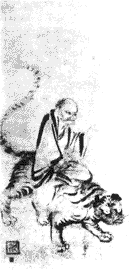:::::::::::::::::::::::::::::::::::::::::::::::::::::::::::::::::::::::::::::::::::::::::::::::::::::
The tiger is well known in the art of China and even Japan.
Here is a Daruma riding a Tiger from my collection of Fushimi Clay Dolls.

The figure may in fact be Bukan.
虎に乗っているのは中国の禅僧豊干(ぶかん)
Bukan's name in Chinese is Feng-Kan and this Zen eccentric is maybe best known from the picture of the "Four Sleepers", Feng-Kan leaning on his tiger together with Han-shan and Shih-Te (Kanzan, Jittoku in Japanese). This picture is generally interpreted as symbolizing the absolute tranquillity of the universe for those who have attained Enlightenment. Bukan being in full controll of the tiger also signifies a human being in full control of its passions and emotions.
Since Bukan liked to ride his tiger around the monastery to shock other simpler folks, I guess the doll is indeed Bukan and not Daruma. But whoever he is, it's a beautifully made piece of folk art and a great item of my collection. The face of the tiger is just unique.
Read more : Clay Dolls from Fushimi, Bukan and Daruma
Gabi Greve, February 2006
. Tora トラ - 虎 - 寅 Tiger Toys .
:::::::::::::::::::::::::::::::::::::::::::::::::::::::::::::::::::::::::::::::::::::::::::::::::::::
The Four Sleepers, shisui 四睡
The Four Sleepers is a theme which shows Feng-kan and his tiger, and Han-shan and Shih-te all immersed in deep slumber. It seems to have enjoyed considerable popularity among Ch'an and Zen painters.
There seems to be no Chinese text which gives us a clue to the meaning of this unusual and appealing theme. In Japan, it is generally interpreted as symbolizing the absolute tranquillity of the universe for those who have attained Enlightenment.

The Four Sleepers
attr. to Mokuan Reien, 14 C. Muromachi
The painting bears a seal of the artist and a colophon reading as follows:
Old Feng-kan embraces his tiger and sleeps,
All huddled together with Shih-te and Han-shan
They dream their big dream, which lingers on,
While a frail old tree clings to the bottom of the cold precipice.
Shao-mu of the Hsiang-fu [temple] salutes with folded hands.
-from Zen Painting and Calligraphy
by J. Fontein and M.L. Hickman
© http://www.coldbacon.com/foursleepers.html
黙庵「四睡図」(前田育徳会)
:::::::::::::::::::::::::::::::::::::::::::::::::::::::::::::::::::::::::::::::::::::::::::::::::::::
The Chinese Tang dynasty monk Fengkan was known for his odd habit of riding a tiger to shock his fellow monks at the Guoching Temple.

Attributed to KANO Motonobu (1476-1559)
Japan, 16th century
pair of hanging scrolls
H.56.0 cm, W.110.5 cm
The monk Shide ("shee-duh") was a man who Fengkan discovered and brought to the temple, and who himself recruited poet-to-be Hanshan by giving him leftover rice. The right hand scroll of this pair shows Fengkan sitting on the back of his tiger, while the left shows Shide holding a broom as Hanshan smiles.
Though there are many works of Zen ink painting showing these three characters, examples depicting them in a landscape background on a pair of scrolls are quite rare. These paintings have long been ascribed to Kano Motonobu(1476-1559), but the composition follows an older style related to folding screens painted with flowers and birds. The great tension found in this work demonstrates the strength of pictorial art in ink before the formulaic approach of the Kano school was developed.
© Fukuoka Art Museum
http://www.fukuoka-art-museum.jp/english/ec/html/ec03/01/bukan.html
:::::::::::::::::::::::::::::::::::::::::::::::::::::::::::::::::::::::::::::::::::::::::::::::::::::
Zen Master Bukan with Tiger
by Ko Ryuko (1801-1859)
Dimensions (inches) : 15.00" (width) x 51.00" (height)

The Chinese Zen eccentric, Bukan, was a sidekick of Kanzan and Jittoku. Bukan had a pet tiger and often the four friends—Kanzan, Jittoku, Bukan, and the tiger—are portrayed as the "Four Sleepers," napping peacefully in Zen repose. Here, however, Bukan is by himself, hanging out deep in the mountains with his tiger buddy. Like Kanzan and Jittoku, Bukan represents Zen freedom and spontaneity, and harmony with (buddha-)nature.
About the Artist
Ko Ryuko, born in what is now Fukushima Prefecture, studied painting with the master Tani Buncho in Edo (now Tokyo). He later settled in Kyoto, where he became well-known as an artist. On occasion, Ryuko brushed Zenga and this is one of his most charming pieces.
© 2004 Shambhala Publications
:::::::::::::::::::::::::::::::::::::::::::::::::::::::::::::::::::::::::::::::::::::::::::::::::::::

© Michael Hofmann BUKAN zenji
calligraphy : Jikihara Gyokusei
http://www.fsinet.or.jp/~ttstudio/hof-02.html
:::::::::::::::::::::::::::::::::::::::::::::::::::::::::::::::::::::::::::::::::::::::::::::::::::::
可翁筆「豊干禅師図」

© Copyright 1996 the University Museum, the University of Tokyo
:::::::::::::::::::::::::::::::::::::::::::::::::::::::::::::::::::::::::::::::::::::::::::::::::::::
Kanzan and Jittoku 寒山拾得 Daruma Museum
Tiger Archives of this DRAGON Gallery
Tiger a kigo for haiku トラ とら 虎 寅
... World Kigo Database ...
:::::::::::::::::::::::::::::::::::::::::::::::::::::::::::::::::::::::::::::::::::::::::::::::::::::








1 comment:
.
Hokku by Basho
tsuki ka hana ka toedo shisui no ibiki kana
moon? blossoms?
to such questions,
just four sleepers snoring
Note: "Written on a painting of four Buddhist monks sleeping."
Post a Comment